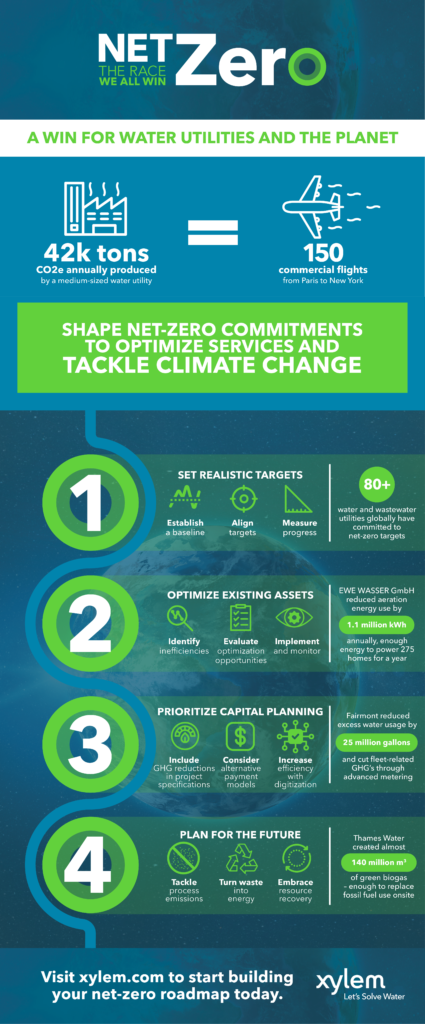Net Zero: Mapping the route to water utility decarbonization
The water sector has a role to play in the global effort to achieve net-zero greenhouse gas emissions and help to slow climate change. Our sector is energy-intensive, and technology now gives us an opportunity to manage water much more efficiently. Net Zero: The Race We All Win, a new paper from Xylem, spotlights innovative, real-world strategies that utilities can use to reduce emissions quickly and affordably, while still meeting their community and regulatory commitments.
Austin Alexander, Vice President, Sustainability and Social Impact at Xylem, shares her thoughts about the importance of decarbonization for the sector and some of the highlights from the paper.
Why is net zero a priority for the water sector?
Water and wastewater infrastructure make up approximately 2% of global greenhouse gas (GHG) emissions, which is a similar amount to the global shipping industry. For a sector typically considered for its important sustainability outcomes, like protecting water bodies and providing reliable clean water services, it is uncomfortable to consider our shared contribution to climate change. We are in a moment when industries around the world are thinking about how to effectively decarbonize. It’s our view that water should be leading the way.
I’m optimistic because I’ve seen what utilities can do and have already done – and because we aren’t looking for a quantum leap in technology. Much of what we need exists and is relatively easy to leverage right now while complying with regulatory requirements. Additionally, we are seeing more and more innovative technology enter the water space. This means as a sector, we have a real and immediate opportunity for water to be one of the fastest sectors to decarbonize.
Where should utilities start?
Setting targets is important, it gives you a baseline to work from and a realistic goal to hit. What we say to utilities is that you don’t need to reinvent the wheel. Lots of work has already been done, so lean on that. Many companies, including Xylem, have publicly disclosed targets and plans so there is a lot to learn from.
There are also resources and organizations dedicated to helping, so reach out to places like the SBTi (Science Based Targets Initiative) to help build a bit of momentum.
What’s the next step – how does a utility get on the ladder and start its journey to decarbonization?
Targets are a great start, but they aren’t going to reduce emissions. Efficient technologies – together with changes in process, policy, and practice – will.
Start with things that are cost-neutral, or close to it. There are lots of routes here – one we advocate is taking a long hard look at what the root cause of inefficiencies are across a network.
In our previous research, we found about 50 percent of energy-related emissions from the wastewater sector can be abated with existing technologies – think intelligent wastewater pumping systems, adaptive mixers with variable speed drives, and real-time decision support systems. The really striking figure was that about 95 percent of this impact is achievable at zero or negative cost.
Our new paper highlights innovative strategies in action from utilities that are leading the charge to decarbonize. One example is EWE WASSER GmbH (EWE), in Cuxhaven, one of northwest Germany’s largest wastewater disposal companies. By creating a digital twin of their systems, the utility was able to gain visibility into and optimize its operations, reducing aeration energy use by 30 percent and saving 1.1 million kWh annually, while ensuring effluent water quality compliance. Other innovative approaches explored include remote, real-time monitoring, intelligent pump stations, and generating renewable power from waste.
It is also important to say that utilities need support – the onus can’t just be on them. This isn’t easy, the sector is already on the front line of the impacts of climate change, from drought to floods. The broader ecosystem of stakeholders – politicians, regulators, finance partners, technology partners, etc. – need to help remove hurdles and support rapid adoption. The term net zero can feel daunting – but it’s important to remember this is a long journey. The most important action is the first step taken.
At Xylem, we believe the water sector has an extraordinary opportunity to solve water and help create a more sustainable world. The components of success are available: technologies, experience, funding, collaboration, and, increasingly, regulatory incentives. We can be the sector that decarbonizes at pace, all while making sure to provide life-giving services to all.
Read more about the strategies water utilities can take to hit net-zero targets in Xylem’s latest paper – Net Zero: The Race We All Win.
Relevant Content
IWA Climate Smart Utilities Initiative
IWA Climate Smart Utilities
The Goal of the initiative is to assist water, wastewater, and urban drainage companies in improving their climate resilience by adapting to a changing climate while contributing to significant and sustainable reduction of carbon emissions. The initiative aims to deliver value to utilities and inspire the wider water professional community.


